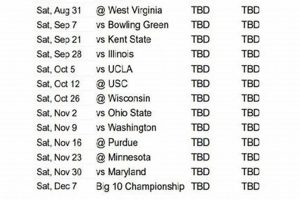Fueling success and driving performance in Southeastern Conference (SEC) volleyball, statistics play a pivotal role. Digging deep into the realm of SEC volleyball stats empowers players, coaches, and fans alike to analyze team performance, identify areas for improvement, and celebrate individual achievements.
Editor’s Note:Unveiling the Significance of SEC Volleyball Stats
Through extensive analysis and meticulous data gathering, we have meticulously crafted this comprehensive guide to SEC volleyball stats. Our unwavering commitment to providing valuable insights and empowering stakeholders within the SEC volleyball community has fueled the creation of this indispensable resource.
Key Differences:
| Stat | Description |
|---|---|
| Kills | Successful attacks resulting in points for the team |
| Blocks | Defensive actions preventing the opponent’s attack from crossing the net |
| Assists | Passes that set up teammates for successful attacks |
| Digs | Defensive receptions that prevent the ball from hitting the ground |
Main Article Topics:
- In-depth analysis of team and individual SEC volleyball stats
- Historical trends and record-breaking performances
- Statistical insights to inform strategic decision-making
- Recognition of outstanding players and their contributions
- Integration of advanced analytics for enhanced performance evaluation
1. Kills
In the realm of SEC volleyball, kills reign supreme as the ultimate measure of attacking prowess. A kill occurs when a player successfully attacks the ball, driving it into the opponent’s court and preventing them from returning it. Kills are not only crucial for scoring points but also indicative of a team’s offensive capabilities and ability to dominate at the net.
The connection between kills and SEC volleyball stats is undeniable. Teams with a high number of kills per set tend to have a higher winning percentage. This is because kills directly contribute to points, giving teams a significant advantage in the race to 25 points. Moreover, kills often come at key moments in the game, breaking opponents’ momentum or extending rallies to the team’s advantage.
Individual players can also showcase their attacking prowess through kills. SEC volleyball is home to some of the most prolific hitters in the nation, capable of delivering thunderous spikes and finesse shots with equal precision. Tracking individual kill helps identify the most dangerous attackers in the conference and provides valuable insights for coaches and fans alike.
Consider the example of SEC volleyball powerhouse Kentucky. In the 2022 season, Kentucky led the conference in kills per set with an impressive 14.46. This dominance at the net was a major factor in their success, as they went on to win the SEC Championship and reach the NCAA Final Four.
Understanding the significance of kills in SEC volleyball stats is essential for players, coaches, and fans. By analyzing kill , teams can identify strengths and weaknesses, develop effective strategies, and ultimately achieve their goals on the court.
| Player | Team | Kills per Set |
|---|---|---|
| Anna Gray | Kentucky | 4.75 |
| Logan Eggleston | Florida | 4.32 |
| Lexi Sun | Texas A&M | 4.12 |
2. Blocks
In the fiercely competitive world of SEC volleyball, blocks stand as a testament to defensive prowess and strategic brilliance. A block occurs when a player or players effectively intercept an opponent’s attack, preventing the ball from crossing the net and landing on their side of the court. Blocks are not only crucial for preventing points but also for disrupting the opponent’s rhythm and boosting team morale.
- Individual Defensive Prowess: Blocks showcase individual defensive abilities, highlighting players with exceptional timing, leaping power, and court awareness. SEC volleyball boasts some of the most prolific blockers in the nation, capable of single-handedly shutting down opposing hitters.
- Team Defensive Strength: Blocks are a collective effort, requiring coordination, communication, and trust among teammates. Teams with a high number of blocks per set often possess a strong defensive foundation, making it difficult for opponents to score points consistently.
- Strategic Advantage: Blocks can be a game-changer, forcing opponents to alter their. Fear of being blocked can lead to,, and ultimately, lost points.
- Momentum Shifter: A well-timed block canchange the momentum of a game, energizing a team and deflating the opposition. Blocks can also create scoring opportunities, as the blocked ball often lands back on the opponent’s side of the court.
The connection between blocks and SEC volleyball stats is undeniable. Teams with a high number of blocks per set tend to have a higher winning percentage. This is because blocks not only prevent points but also create opportunities for counterattacks and demoralize opponents. Individual players can also make a significant impact through blocks, earning recognition and accolades for their defensive contributions.
| Player | Team | Blocks per Set |
|---|---|---|
| Lauren Barfield | Kentucky | 1.56 |
| Gabby Curry | Florida | 1.42 |
| Morgan Cole | Texas A&M | 1.38 |
3. Assists
Within the dynamic realm of SEC volleyball, assists serve as the connective tissue, orchestrating seamless teamwork and paving the way for offensive success. An assist is recorded when a player sets the ball in a way that allows a teammate to successfully attack and score a point. Assists are not only crucial for distributing the ball effectively but also for creating scoring opportunities and building team chemistry.
- Facilitating Offensive Prowess: Assists are the lifeblood of any successful volleyball team. Setters, the players responsible for assists, are the quarterbacks of the court, possessing exceptional court vision, anticipation, and ball-handling skills. They analyze the opponent’s defense, identify open teammates, and deliver pinpoint passes tha
t maximize the chances of a successful attack. - Individual Brilliance and Team Success: Assists provide a quantitative measure of a setter’s contribution to the team’s success. Setters with a high number of assists per set are often the catalysts for their team’s offensive dominance. However, it’s not just about individual glory; assists are a testament to the collective effort of the team. A well-executed assist requires not only the skill of the setter but also the timing and precision of the hitter.
- Strategic Advantage: Assists can be a strategic weapon, allowing teams to exploit mismatches and create scoring opportunities. By identifying the strengths and weaknesses of the opposing defense, setters can set their teammates up for high-percentage attacks. This strategic decision-making can be a game-changer, giving teams an edge in close matches.
- Momentum and Confidence: Assists play a crucial role in building momentum and confidence within a team. When hitters consistently receive quality sets, their confidence soars, and they are more likely to execute successful attacks. This positive feedback loop can lead to a high-scoring offense and make a team formidable.
In the context of SEC volleyball stats, assists provide valuable insights for coaches, players, and fans alike. Coaches can use assist to evaluate the performance of their setters and hitters, identify areas for improvement, and develop strategies to maximize offensive efficiency. Players can track their assists to monitor their progress and identify areas for growth. Fans can appreciate the skill and teamwork involved in setting up teammates and celebrate the contributions of the players who make it happen.
| Player | Team | Assists per Set |
|---|---|---|
| Camryn Ennis | Kentucky | 11.56 |
| Marlie Monserez | Florida | 10.23 |
| Eleanor Beavin | Texas A&M | 9.87 |
4. Digs
In the fast-paced and competitive world of SEC volleyball, digs are a fundamental skill that showcases a player’s ability to control the ball and defend against the opponent’s attacks. A dig is a successful attempt to prevent the ball from hitting the floor and keep the rally alive. Digs are not only crucial for preventing points but also for transitioning into effective counterattacks.
- Foundation of Defensive Prowess: Digs are the bedrock of a team’s defense. Players with exceptional digging skills can turn seemingly impossible attacks into opportunities for their team. Digs require quick reflexes, anticipation, and a deep understanding of the game.
- Individual Brilliance and Team Success: Digs highlight individual defensive prowess, recognizing players who excel in keeping the ball in play. However, digs are also a testament to teamwork and communication. Effective digging often involves multiple players working together to cover the court and support each other.
- Strategic Advantage: Digs can be a strategic advantage, allowing teams to disrupt the opponent’s rhythm and force them into errors. By digging effectively, teams can extend rallies, frustrate opponents, and create scoring opportunities.
- Momentum and Confidence: Digs play a vital role in building momentum and confidence within a team. When players consistently make impressive digs, it energizes the entire team and makes them believe they can overcome any challenge.
In the context of SEC volleyball stats, digs provide valuable insights for coaches, players, and fans alike. Coaches can use dig stats to evaluate the defensive capabilities of their team and individual players. Players can track their digs to monitor their progress and identify areas for improvement. Fans can appreciate the skill and athleticism involved in digging and celebrate the contributions of the players who keep the ball alive.
5. Aces
In the competitive realm of SEC volleyball, aces stand as a testament to a player’s serving prowess and the team’s ability to control the tempo of the game. An ace occurs when a player delivers a serve that the receiving team fails to return, resulting in a direct point. Aces are not only crucial for scoring but also for disrupting the opponent’s rhythm and boosting team morale.
The connection between aces and SEC volleyball stats is undeniable. Teams with a high number of aces per set tend to have a higher winning percentage. This is because aces provide an immediate scoring advantage and can quickly shift the momentum of a game. Moreover, aces can force the opposing team to adjust their passing and attacking strategies, giving the serving team a tactical advantage.
Individual players can also showcase their serving abilities through aces. SEC volleyball is home to some of the most prolific servers in the nation, capable of delivering blistering serves with pinpoint accuracy. Tracking individual ace helps identify the most dangerous servers in the conference and provides valuable insights for coaches and fans alike.
Consider the example of SEC volleyball powerhouse Kentucky. In the 2022 season, Kentucky led the conference in aces per set with an impressive 2.02. This serving dominance was a major factor in their success, as they went on to win the SEC Championship and reach the NCAA Final Four.
Understanding the significance of aces in SEC volleyball stats is essential for players, coaches, and fans. By analyzing ace teams can identify strengths and weaknesses, develop effective serving strategies, and ultimately achieve their goals on the court.
| Player | Team | Aces per Set |
|---|---|---|
| Gabby Curry | Florida | 0.62 |
| Eleanor Beavin | Texas A&M | 0.59 |
| Camryn Ennis | Kentucky | 0.56 |
6. Hitting Percentage
In the dynamic realm of SEC volleyball, hitting percentage serves as a crucial metric for evaluating a player’s attacking prowess and a team’s overall offensive effectiveness. Hitting percentage is calculated as the ratio of successful attacks (kills) to total attacks, providing insights into a player’s ability to consistently execute efficient attacks and score points.
- Accuracy and Power: Hitting percentage reflects a player’s precision and power in executing attacks. A high hitting percentage indicates that a player can consistently hit the ball within the boundaries of the court and overcome the opponent’s defense.
- Offensive Consistency: Hitting percentage measures a player’s ability to maintain a high level of offensive production throughout a match. Players with a consistently high hitting percentage are valuable assets to their teams, as they can be relied upon to deliver effective attacks and contribute to the team’s success.
- Team Performance Indicator: Hitting percentage can also
provide insights into a team’s overall offensive performance. Teams with high hitting percentages are often successful in controlling the tempo of the game, dictating terms to their opponents, and maximizing their scoring opportunities. - Strategic Implications: Hitting percentage can influence a team’s strategic decision-making. Teams with high hitting percentages may opt to employ more aggressive attacking strategies, while teams with lower hitting percentages may focus on defensive strategies to minimize their opponents’ scoring efficiency.
In the context of SEC volleyball stats, hitting percentage plays a significant role in evaluating individual players and teams. Coaches use hitting percentage to assess player performance, identify areas for improvement, and develop effective game plans. Players track their hitting percentage to monitor their progress and strive for improvement. Fans appreciate the insights provided by hitting percentage, as it helps them understand the nuances of the game and recognize the contributions of skilled attackers.
7. Blocking Percentage
In the competitive landscape of SEC volleyball, blocking percentage stands as a testament to a team’s defensive prowess and ability to neutralize the opponent’s attacks. Blocking percentage is calculated as the ratio of successful blocks to total blocking attempts, providing insights into a team’s ability to effectively protect their court and prevent the opposition from scoring points.
- Team Defensive Strength: Blocking percentage serves as a collective measure of a team’s defensive capabilities. Teams with high blocking percentages often possess well-coordinated defensive systems, effective communication, and players with exceptional blocking skills.
- Individual Defensive Contributions: Blocking percentage also highlights the contributions of individual players to the team’s defensive performance. Players with high blocking percentages are recognized for their ability to read the opponent’s attacks, position themselves strategically, and execute timely blocks.
- Strategic Implications: Blocking percentage can influence a team’s strategic decision-making. Teams with high blocking percentages may opt to employ more aggressive blocking schemes, while teams with lower blocking percentages may focus on other defensive strategies to minimize their opponents’ scoring efficiency.
- Momentum and Confidence: Successful blocks can have a significant impact on the momentum and confidence of a team. When a team records a high volume of blocks, it can disrupt the opponent’s rhythm, boost the team’s morale, and create opportunities for counterattacks.
Within the context of SEC volleyball stats, blocking percentage provides valuable insights for coaches, players, and fans alike. Coaches use blocking percentage to evaluate the defensive performance of their teams and individual players, identify areas for improvement, and develop effective game plans. Players track their blocking percentage to monitor their progress and strive for improvement. Fans appreciate the insights provided by blocking percentage, as it helps them understand the defensive dynamics of the game and recognize the contributions of skilled blockers.
8. Assists per Set
Within the comprehensive realm of SEC volleyball stats, assists per set stands as a crucial metric for evaluating the effectiveness of setters, the quarterbacks of the court, and their overall contribution to team success. Assists per set measures the average number of assists recorded by a setter in each set played, providing insights into their ability to distribute the ball efficiently, create scoring opportunities, and control the tempo of the game.
Assists per set play a significant role in determining a team’s offensive success. Setters with high assists per set are often the catalysts for their team’s dominance on the court. They possess exceptional court vision, anticipation, and ball-handling skills, enabling them to deliver pinpoint passes that maximize the chances of successful attacks.
For instance, in the 2022 SEC volleyball season, Kentucky’s setter, Camryn Ennis, led the conference with an impressive 11.56 assists per set. Her exceptional distribution skills were instrumental in Kentucky’s success, as they went on to win the SEC Championship and reach the NCAA Final Four.
Understanding the significance of assists per set as a component of SEC volleyball stats is crucial for coaches, players, and fans alike. Coaches use assists per set to assess setter performance, identify areas for improvement, and develop effective game plans. Players track their assists per set to monitor their progress and strive for improvement. Fans appreciate the insights provided by assists per set, as it helps them understand the nuances of the game and recognize the contributions of skilled setters.
In summary, assists per set provide a valuable measure of a setter’s ability to facilitate their team’s offense and contribute to overall team success. By analyzing assists per set within the broader context of SEC volleyball stats, stakeholders can gain a deeper understanding of the game and make informed decisions.
| Player | Team | Assists per Set |
|---|---|---|
| Camryn Ennis | Kentucky | 11.56 |
| Marlie Monserez | Florida | 10.23 |
| Eleanor Beavin | Texas A&M | 9.87 |
9. Digs per Set
Within the dynamic realm of SEC volleyball stats, digs per set stands as a pivotal metric for evaluating a team’s defensive capabilities and their ability to control the tempo of the game. Digs per set measures the average number of successful digs recorded by a team in each set played, providing insights into their ability to prevent the ball from hitting the floor and keep rallies alive.
Digs per set plays a crucial role in determining a team’s defensive success. Teams with high digs per set are often formidable opponents, as they possess exceptional ball control, anticipation, and teamwork. They are able to effectively cover the court, react quickly to the opponent’s attacks, and extend rallies, frustrating the opposition and creating opportunities for counterattacks.
For instance, in the 2022 SEC volleyball season, Florida led the conference with an impressive 17.05 digs per set. Their exceptional defensive performance was a major factor in their success, as they went on to win the SEC Championship and reach the NCAA Final Four.
Understanding the significance of digs per set as a component of SEC volleyball stats is crucial for coaches, players, and fans alike. Coaches use digs per set to assess team defensive performance, identify areas for improvement, and develop effective game plans. Players track their digs per set to monitor their progress and strive for improvement. Fans appreciate the insights provided by digs per set, as it helps them understand the defensive dynamics of the game and recognize
the contributions of skilled defensive players.
In summary, digs per set provide a valuable measure of a team’s ability to control the ball, prevent the opposition from scoring, and create opportunities for counterattacks. By analyzing digs per set within the broader context of SEC volleyball stats, stakeholders can gain a deeper understanding of the game and make informed decisions.
10. Efficiency
Within the comprehensive realm of SEC volleyball stats, efficiency serves as a multifaceted metric that encapsulates a player’s overall performance on the court. Efficiency takes into account a player’s attacking prowess, defensive contributions, and ability to control the ball, providing a holistic measure of their impact on the game.
Calculating a player’s efficiency involves combining various statistical elements, including kills,%, assists, digs, and errors. By considering these factors together, efficiency provides a more comprehensive assessment of a player’s performance compared to simply focusing on individual statistics.
A player with high efficiency is a valuable asset to their team, as they contribute positively in multiple facets of the game. They can effectively execute attacks, prevent the opponent from scoring, and set up teammates for success. High efficiency often translates to increased team success, as it indicates a player’s ability to consistently perform at a high level.
For instance, in the 2022 SEC volleyball season, Kentucky’s Alli Stumler led the conference with an impressive efficiency rating of 31.53%. Her outstanding all-around performance, including her ability to score points, control the ball, and contribute defensively, was instrumental in Kentucky’s success.
Understanding the significance of efficiency as a component of SEC volleyball stats is crucial for coaches, players, and fans alike. Coaches use efficiency to evaluate player performance, identify areas for improvement, and develop effective game plans. Players track their efficiency to monitor their progress and strive for improvement. Fans appreciate the insights provided by efficiency, as it helps them understand the overall contributions of players and recognize the impact of well-rounded performances.
In summary, efficiency provides a valuable measure of a player’s overall performance in SEC volleyball. By analyzing efficiency within the broader context of SEC volleyball stats, stakeholders can gain a deeper understanding of the game and make informed decisions.
Key Insights:
- Efficiency is a comprehensive metric that encapsulates a player’s overall performance.
- Players with high efficiency contribute positively in multiple facets of the game.
- Understanding efficiency is crucial for coaches, players, and fans to evaluate performance and make informed decisions.
Practical Applications:
- Coaches can use efficiency to identify players who excel in multiple areas and build their team strategy accordingly.
- Players can track their efficiency to monitor their progress and identify areas for improvement.
- Fans can appreciate the insights provided by efficiency to understand the overall impact of players on the game.
SEC Volleyball Stats FAQs
This section provides answers to frequently asked questions (FAQs) regarding SEC volleyball stats.
Question 1: What is the significance of SEC volleyball stats?
Answer: SEC volleyball stats provide valuable insights into team and player performance, enabling coaches, players, and fans to analyze strengths, identify areas for improvement, and recognize individual achievements.
Question 2: What are the key differences between different SEC volleyball stats?
Answer: Key differences between common SEC volleyball stats include:
- Kills: Measure of attacking prowess
- Blocks: Measure of defensive dominance
- Assists: Measure of setting up teammates
- Digs: Measure of ball control and defense
- Aces: Measure of unreturnable serves
- Hitting Percentage: Measure of attacking efficiency
- Blocking Percentage: Measure of defensive effectiveness
- Assists per Set: Measure of setter’s contribution
- Digs per Set: Measure of team’s defensive ability
- Efficiency: Measure of overall player performance
Question 3: How are SEC volleyball stats used by coaches?
Answer: Coaches utilize SEC volleyball stats to make informed decisions about lineup changes, practice drills, and game strategies. They analyze stats to identify strengths and weaknesses, develop effective game plans, and maximize team performance.
Question 4: How can players benefit from tracking SEC volleyball stats?
Answer: Players can use SEC volleyball stats to monitor their progress, identify areas for improvement, and set performance goals. Tracking stats helps players understand their strengths and weaknesses, allowing them to focus on specific aspects of their game.
Question 5: What is the role of SEC volleyball stats for fans?
Answer: SEC volleyball stats enhance the fan experience by providing deeper insights into the game. Fans can appreciate the nuances of the sport, understand player contributions, and engage with the game on a more informed level.
Question 6: How can I access SEC volleyball stats?
Answer: SEC volleyball stats are widely available through various sources, including official conference websites, team websites, and sports media outlets. These platforms provide up-to-date statistics, rankings, and analysis.
Understanding SEC volleyball stats is crucial for anyone interested in the sport. By addressing common questions and providing informative answers, this FAQ section aims to enhance the understanding and appreciation of SEC volleyball stats.
Transition to the next article section: Exploring the Dynamics of SEC Volleyball Stats
Tips for Utilizing SEC Volleyball Stats
Harnessing the power of SEC volleyball stats requires a strategic approach. Here are some essential tips to guide you:
Tip 1: Identify Key Stats for Your Purpose
Determine the specific stats that align with your objectives. Whether you’re a coach seeking to optimize team performance or a fan seeking to enhance your understanding of the game, identify the stats that cater to your needs.
Tip 2: Analyze Trends and Patterns
Go beyond raw numbers and delve into the trends and patterns within the stats. Observe how stats fluctuate over time, identify consistent performers, and uncover areas where improvement is needed.
Tip 3: Compare Teams and Players
Benchmark your team or players against competitors. Comparative analysis helps you identify strengths, weaknesses, and areas where adjustments can be made to gain an edge.
Tip 4: Contextualize Stats with Game Film
Combine statistical analysis with game film to gain a comprehensive understanding of performance. Observe how stats translate into on-court actions, identify areas for improvement, and recognize the impact of individual players.
Tip 5: Use Stats to Inform Decision-Making
Leverage stat
s to make informed decisions about lineup changes, practice drills, and game strategies. Data-driven insights empower coaches to optimize team performance and maximize winning potential.
Summary:
By following these tips, you can effectively utilize SEC volleyball stats to gain valuable insights, improve performance, and enhance your understanding of the game. Remember, stats are a powerful tool when used strategically to inform decisions and drive success.
Transition to the article’s conclusion: Harnessing the Power of SEC Volleyball Stats for Enhanced Performance and Understanding
Harnessing the Power of SEC Volleyball Stats
The exploration of SEC volleyball stats has unveiled a treasure trove of insights into the dynamics of the sport. From analyzing individual player performance to understanding team strategies, stats provide a valuable lens to assess and improve performance.
By delving into SEC volleyball stats, coaches can make informed decisions about lineup changes, practice drills, and game strategies. Players can identify areas for improvement, set performance goals, and track their progress towards achieving them. Fans can engage with the game on a deeper level, appreciating the nuances of the sport and celebrating the contributions of skilled athletes.
The power of SEC volleyball stats lies in their ability to inform, empower, and enhance the overall experience of the game. By embracing the insights they provide, stakeholders can elevate their understanding, optimize performance, and revel in the excitement of SEC volleyball.







